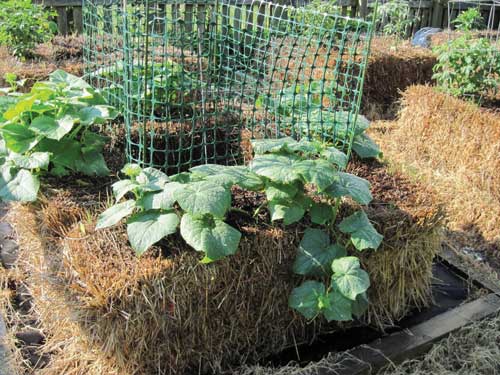
Hay Bale Gardening
Download a PDF of this fact sheet.

A bale garden uses hay or straw bales in place of soil. Seeds can be planted directly on top of the bale or seedlings can be used. Bale gardening is one way to garden if you do not have a lot of soil or space; or if your soil is hard to work. Bale gardening is also easier on your hands and wrists, especially if you have arthritis and other musculoskeletal conditions.
Most vegetables, flowers, or herbs that you want to grow in the ground, can be grown in bales. Tomatoes, peppers, cucumbers, squash, melons, broccoli, cauliflower, marigolds, petunias, basil, cilantro, and parsley are only a few of the plants that do well growing in bales.
You can make your garden into any shape you want with bales. You can make long rows by placing the bales end-to-end. Bales can be grouped together to make traditional, rectangular garden beds. You can also make your garden into a design or maze by where and how you place your bales.
General Method

Hay or straw bales need to be prepared for planting. Although bales can be used in place of soil, they do not have all the nutrients found in soil that plants need to grow. It will take about ten days to prepare your bales. There are a lot of different ways to prepare bales for planting. The steps below are a general guide.
- Water and keep the bales wet for the entire ten days.
- On the fourth day, pour five ounces (ten tablespoons) of ammonium nitrate fertilizer onto the bales. This fertilizer is often used by farmers and gardeners. Miracle Gro, Flurin, and Hibiscus are all brands that have ammonium nitrate in them.
- On the seventh day, pour two and one half ounces (or five tablespoons) of ammonium nitrate fertilizer on the bales.
- On the tenth day, pour 12 ounces (1 cup) of fertilizer with an N-P-K ratio of 13-13-13 on the bales and water. N-P-K stands for nitrogen, phosphorous, and potassium. These are nutrients that your plants need to grow. The numbers stand for how much of these nutrients is in the fertilizer by weight. You can find this information on the fertilizer's label. Some fertilizers that have this ratio are Spectrum, Jobe, Once-A-Year Plant Fertilizer, and Greenleaf.
- If you want to grow your garden from seed, put three inches of potting soil or top soil on top of the bales. Plant your seeds in the soil.
- If you are using seedlings to start your garden, you do not need to put potting soil on top of the bale. Plant seedlings by driving a trowel into the bale. Lever the trowel to force the bale slightly apart. Plant the seedling in the space you made between the flakes (sections that make up a bale). Let the bale spring back together again.
Tips and Tricks

- Bales that do best as garden beds are tightly bound with synthetic twine. Bales that are bound tightly with synthetic twine are less likely to fall apart through the growing season. Bales that are loosely bound may fall apart faster.
- Bales may need to be watered up to two times a day, every day. You cannot over water the bales. They will dry out quickly because bales do not store water or 'hold on to it' like soil does.
- Both hay and straw bales have seeds in them. Grass may sprout if you use hay bales. Grain plants may sprout if you use straw. Sprouts can either be pulled out or trimmed.
- The same spacing you use to grow plants in the ground is the same spacing plants need to grow in bales. In general, one bale can handle about three broccoli plants, three cauliflower plants, two pumpkin hills, or two tomato plants.
- If you grow taller vegetables and flowers, like corn and sunflowers, then they may fall over. Bales will not give tall plants the support they need to stay upright. If you want to plant taller vegetables and flowers, think about using a strong and tall staking system. Even tomato plants will need to be staked in a more sturdy way than you would normally need to do in traditional gardening.
Resources
There is no right or wrong way to build a bale garden. The information in this sheet is a basic guide to building your own. For more details on bale gardening, check out these resources:
- Visit www.no-dig-vegetablegarden.com for information and designs on no-dig gardening methods.
- Visit www.strawbalegardens.com for many different ideas for your bale garden.
If you would like to talk to someone about accessible gardening, or would like a garden assessment done, call Geen Thumbs, Healthy Joints at 800-841-8436.

